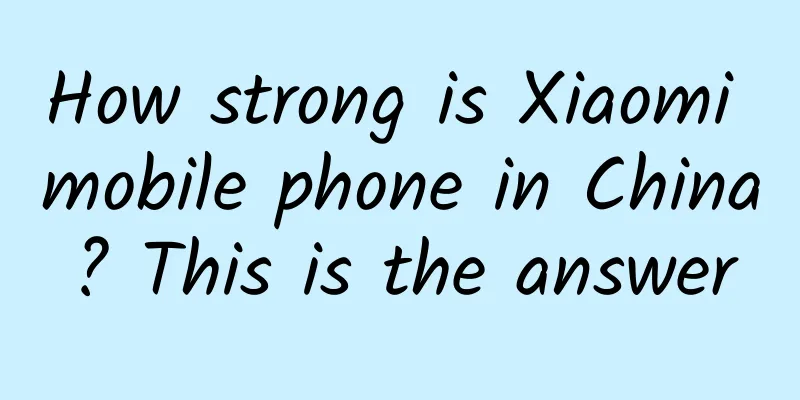How strong is Xiaomi mobile phone in China? This is the answer

|
I got the internal data of China Mobile's mobile phones in March and April from a friend. Although it is biased to analyze the changes of various manufacturers based on China Mobile's data alone, it is obviously more objective than the data of other third-party research institutions. Note: The data in the table is the number of new mobile phones that joined China Mobile's network in March and April, including both sales bundled with operators and purchases by consumers from social channels and e-commerce, which objectively reflects the dynamic changes of consumers' new mobile phone purchases. Although the data in the table only reflect the rankings for March and April, it can still reflect some of the latest changes and trends in China's mobile phone market: 1. Xiaomi tops the list. The biggest highlight of the mainland mobile phone market in the past few years is the sudden rise of Xiaomi by leveraging the transformation of traditional channels by e-commerce. I believe that no one now doubts that as a new brand, Xiaomi has established itself as a first-tier brand in China. The main question at present should be how high the ceiling of Xiaomi's growth is. Judging from the current trend, there is not much suspense about Xiaomi's leap to the top of the mainland mobile phone market in 2014. The main suspense is what the ceiling of Xiaomi's market share is. Lao Yao once predicted that Xiaomi would top the mainland market with a market share of nearly 20% in the third quarter of this year. The number one brand, but if the driving force of Xiaomi's explosive growth before last year came from the acceleration of business model changes, this year's growth should mainly come from inertia. Lao Yao predicts that Xiaomi's market share will decline after topping the list in the third or fourth quarter. 2. The explosion of vivo and OPPO If Xiaomi is the star manufacturer in the mainland mobile phone market in 2013, it must be Xiaomi. However, the star brand in the mainland in the first half of 2014 so far is not Xiaomi, whose sales have doubled, nor Coolpad, which ranks first in 4G, nor Huawei, which has made breakthroughs in integrated circuits, but OPPO and vivo, whose sales and profits have skyrocketed. Although the sales of Duan Yongping's twin brands alone cannot surpass Xiaomi this year, the combined sales of the two brands are only a little more than Xiaomi's, and the combined profits will far exceed Xiaomi's. The explosion of vivo and OPPO shows that the brand and quality of any product are the key to determining the ultimate victory in the market. The two companies will also become the main force for mainland brands to challenge Samsung's high-end market. 3. The decline in the share of the operator bundled market In September 2013, the operator bundled market or the operator brand market shipped 6.912 million mobile phones (also from China Mobile's internal data, the same below), and the public brand including traditional channels and e-commerce shipments was 2.798 million units. The operator brand shipments were more than double the public brand shipments. In April 2014, the operator brand shipments shrank to 4.727 million units, and the public brand shipments soared to 4.939 million, surpassing the operator brand shipments, reflecting the rise of e-commerce brands represented by Xiaomi and traditional channel markets represented by vivo and OPPO. 4. The sales volume of mobile phones in mainland China is increasingly concentrated on brands. Although the gap is still not obvious, it is an indisputable fact that the six mainland brands, including operator brands Huawei, Lenovo, Coolpad, e-commerce brand Xiaomi, traditional channel brands vivo and OPPO, form the first group. From last year's four operator brands of China Cool Alliance to now the operator brands, e-commerce brands and traditional channel brands share the world in three parts, it shows that the market is concentrating on brands with obvious characteristics, such as vivo and OPPO's pursuit of aesthetics, Huawei's strategy of driving terminals with HiSilicon, Xiaomi's penetration from e-commerce to operators, etc. The competition among mainland brands is gradually becoming benign, differentiation determines the future trend of brands, and the new competition landscape of mainland brands has basically taken shape. As a winner of Toutiao's Qingyun Plan and Baijiahao's Bai+ Plan, the 2019 Baidu Digital Author of the Year, the Baijiahao's Most Popular Author in the Technology Field, the 2019 Sogou Technology and Culture Author, and the 2021 Baijiahao Quarterly Influential Creator, he has won many awards, including the 2013 Sohu Best Industry Media Person, the 2015 China New Media Entrepreneurship Competition Beijing Third Place, the 2015 Guangmang Experience Award, the 2015 China New Media Entrepreneurship Competition Finals Third Place, and the 2018 Baidu Dynamic Annual Powerful Celebrity. |
>>: Can you share your private Wi-Fi?
Recommend
NetEase H5 screen-sweeping skills and strategies!
During this year's National Day, NetEase main...
A real measurement of household appliances' standby power consumption: set-top boxes steal 10 kWh of electricity a month
While home appliances bring convenience to our liv...
Event planning and promotion: a universal event planning solution!
There is actually no shortcut to planning an even...
Master these 10 design theories to help you make experience designs that are easier to pass
A good design should not only solve the right pro...
What should I do if short videos have no traffic? How can short videos quickly gain traffic?
As short videos are developing better and better,...
Is time a false proposition or an illusion? What does the timeline mean?
There are often discussions on the Internet that ...
What should I do if my car is soaked in water or washed away? This article explains it all, save it now!
The recent heavy rains and floods are worrying. A...
From the "reputation-building missile" to Huawei's "reputation-building aircraft", what other "technological breakthroughs" are there on the road to becoming a strong country that you don't know about?
Planning: Little Dandelion, 91 Copywriter: Xiaoxi...
Stop cleaning up "zombie fans" WeChat official: This is a scam and is extremely harmful
You may have hundreds or even thousands of WeChat...
8 ways to make money with Taoke APP!
This year, the number of friends engaged in Taoba...
What keeps users in your product?
Introduction I once used a canvas belt for six ye...
Dual-core noise reduction, lightweight, Sony WH-1000XM5 sets a new benchmark for noise reduction
In an era when true wireless headphones have beco...
Is eating one egg a day good or bad for your health? Here's the latest research!
"Throw away the yolk of the egg, as the yolk...
Case! 3 major steps for APP to acquire new users
A store without customers will close, and a produ...
Asia-Pacific region can take six measures to build climate-resilient green roads
Sustainable road development balances economic gr...









